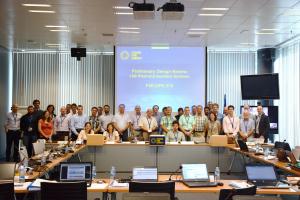Liquid nitrogen plant ready for final design
16 Jan 2015
-
Aris Apollonatos, Fusion for Energy
Think of ITER's cryoplant as a massive fridge that will produce and distribute the cooling power in the machine through different networks. The most advanced cryogenic technologies will be deployed to generate the extremely low temperatures needed for the ITER magnets, thermal shields and cryopumps.
Procurement of the ITER cryoplant will be shared by Europe (liquid nitrogen plant), the ITER Organization (helium plant) and India (cryolines and cryodistribution components).
The liquid nitrogen plant and auxiliary systems will cool down, process, store, transfer and recover the cryogenic fluids of the machine. Two nitrogen refrigerators will be delivered along with two 80 K helium loop boxes, warm and cold helium storage tanks, dryers, heaters and the helium purification system.
A preliminary design phase was completed in mid-2014. In order to comply with the rigorous technical specifications and fabrication, safety, quality and project management requirements, the European Domestic Agency has structured a design review process for its share of cryoplant components that relies on two main entities: the design review steering committee and the design review panel.
The two bodies bring together more than 13 highly qualified experts from the European Domestic Agency, ITER Organization and external organizations, willing to share their knowledge and meticulously examine the technical details that will feed into the final specifications and lead towards the purchase of long-lead items such as compressors, heat exchangers, turbines, tanks and cold circulators.
In October the steering committee, based on the observations of the design review panel, commended the quality and the comprehensiveness of the studies performed by the European Domestic Agency, the ITER Organization and supplier Air Liquide. The system was deemed to be at a level of sufficient maturity to move to the next stage—the final design of the system and the purchase of the heat exchangers, compressors, turbines and tanks which have to be ordered prior to the next design review.


